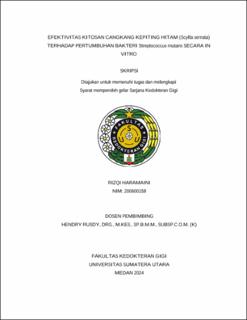| dc.description.abstract | The oral cavity is the place where food enters and contains various kinds of microorganisms and bacteria. Some of these bacteria will cause infectious diseases, one of which is abscesses, even radicular cyst. Radicular cyst is a closed cavity or pathological cap at the tip of a tooyh root (periapical), containing a semi-solid mass or fluid lined by epithelial tissue. One of the bacteria that can cause radicular cyst are bacteria Streptococcus mutans. Prevention of this infection can be done by giving antibiotics. However, its use can cause resistance. Therefore, researchers see an opportunity to utilize nature's potential as an alternative treatment material. One natural ingredient that can be used is black crab shell (Scylla serrata). Black crab shell (Scylla serrata) is a type of mud crab Scylla Spp which has an antibacterial effect against bacteria Streptococcus mutans. The aim of this research was to examine the activity of black crab shell chitosan (Scylla serrated) against bacteria Streptococcus mutans in vitro. This research method is laboratory experimental. This research used black crab shell chitosan with several concentrations, namely 0.5%, 1.0%, 1.5%, 2.0%, 2.5% and a positive control which was then applied to the surface of the paper discs to see the inhibition zone of various concentrations. After that, the inhibition zones of the various concentrations were calculated. The test results were analyzed using the Kruskall Wallis test and Post Hoc test (Mann-Whitney). The results showed average concentration values of 0.5% (8.267mm), 1.0% (8.767mm), 1.5% (8.5mm), 2.0% (9.367mm), 2.5% ( 10.267mm) and positive control (13.73mm). The results of data analysis using the Kruskall Wallis test showed a significant value of p=0.004 (p<0.005). This states that Ho is rejected or black crab shell chitosan (Scylla serrata) has inhibitory power against bacteriaStreptococcus mutans. Furthermore, the results of the Mann Whitney test showed a degree of significance of p=0.046 (p<0.05). So it can be stated that there are significant differences between each treatment group in inhibiting growth Streptococcus mutans. | en_US |


